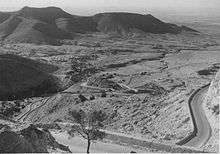Halfaya Pass
Halfaya Pass (Arabic: مَمَرّ حَلْفَيَا translit. Mamarr Ħalfayā, known colloquially as Hellfire Pass) is located in Egypt, near the border with Libya. A 600 feet (180 m) high escarpment extends south eastwards from the Egyptian-Libyan border at the coast at as-Salum (or Saloum, Solum, Sollum), with the scarp slope facing into Egypt. Halfaya Pass is about two miles 2 miles (3.2 km) inland from the Mediterranean and provides a natural route through.
The escarpment is known as Akabah el-Kebir عقبة الكبير (`aqabat al-kabīr) "great ascent". To El-Edrisi it was known as عقبة السلوم (`aqabat as-salūm) "graded ascent", whence the modern name of the gulf and the town of Salum. In antiquity it was known as Catabathmus Magnus. It was considered as marking the boundary between Africa and Asia in Hellenistic geography. It separated the provinces of Aegyptus and Marmarica.
World War II

In World War II, the engineered route up the escarpment had been destroyed and the pass had great strategic importance. The only ways westwards into Libya were to assault the pass or to out-flank it to the south.
After the defeat of the Italian 10th Army on 7 February 1941 during Operation Compass, the Italians were reinforced by German units (Afrika Korps under Erwin Rommel) and the British forces were forced out of Libya, leaving a besieged garrison at Tobruk. On 14 April 1941, Rommel's main force reached Sollum on the Egyptian border and occupied the Halfaya Pass. There were several allied attempts to recapture the Halfaya Pass and relieve Tobruk.
The first attempt, on 15 May, was Operation Brevity. Rommel counter-attacked; the British withdrew and by 27 May the Germans had recaptured Halfaya Pass, a passage of time in which Major Edward Thomas earned his Military Cross. Supply shortages obliged the Germans to curtail their advance, so they dug in and fortified their positions at Halfaya with 88 millimetre guns. This was the anchor for the Axis positions, which opposed the Allied forces during the next allied attack — Operation Battleaxe on 15 June. German armour was deployed to draw the British tanks (11th Hussars) onto the concealed 88mm guns and the first wave was cut down in a few minutes (11 out of 12 tanks were destroyed), earning the pass the nickname "Hellfire Pass". The German commander, Major Wilhelm Bach, in his conduct of the Axis defence of Halfaya Pass earned himself the nickname 'the Pastor of Hellfire Pass' (an allusion to his peacetime occupation as a Lutheran minister). The commander of the larger Italian contingent, General Fedele de Giorgis, General Officer Commanding 55th Infantry Division Savona, was awarded the highest German decoration, the Knight's Cross for the defense he conducted.[1] The allied commander, Major Miles, was last heard on the radio reporting, "They are tearing my tanks apart."
The third attempt, Operation Crusader opened on 18 November, with an attack on Sidi Omar to the west of the pass and an attempt to outflank Rommel to the south and relieve Tobruk. This was achieved on 29 November. Rommel, now under pressure, on 7 December withdrew to El Agheila. Axis garrisons at Sollum, Bardia as well as the Pass were left behind, a temporary thorn in the Allies side. Isolated after the fall of Bardia on 2 January 1942, besieged by Commonwealth forces, cut off from supplies, and bombarded from the air and the sea, Bach and de Giorgis finally surrendered the Halfaya garrison of 4,200 Italians of the 55th Savona Infantry Division and 2,100 Germans,[2] to the South African 2nd Infantry Division on 17 January 1942.[3]
Halfaya Pass was the location of the accidental death of Major-General 'Jock' Campbell (VC), then commander of the British 7th Armoured Division. On 26 February 1942, a month after assuming command, his staff car skidded on a newly laid clay road surface, killing him outright.[4]
In Popular Culture
The Halfaya Pass and its according battles play a role in the Sniper Elite III game plot.
The Halfaya Pass is the location for the Battlefield V map Hamada.[5]
References
- http://rommelsriposte.com/2011/06/17/the-end-of-the-halfaya-garrison/
- Playfair, p. 95.
- http://rommelsriposte.com/2011/06/17/the-end-of-the-halfaya-garrison/
- Mead (2007), p. 90
- "THE MAPS OF BATTLEFIELD V: HAMADA". ea.com. Electronic Arts. Retrieved 10 March 2019.
Bibliography
- Mead, Richard (2007). Churchill's Lions: A biographical guide to the key British generals of World War II. Stroud (UK): Spellmount. p. 544 pages. ISBN 978-1-86227-431-0.